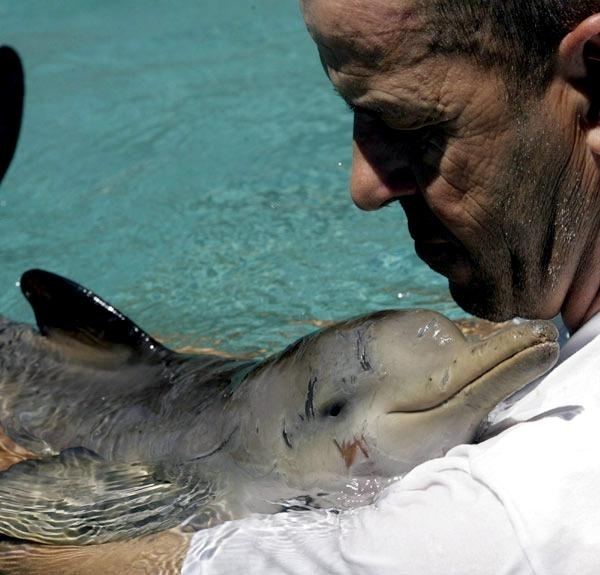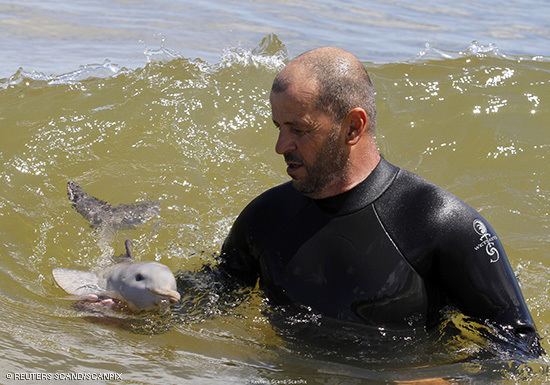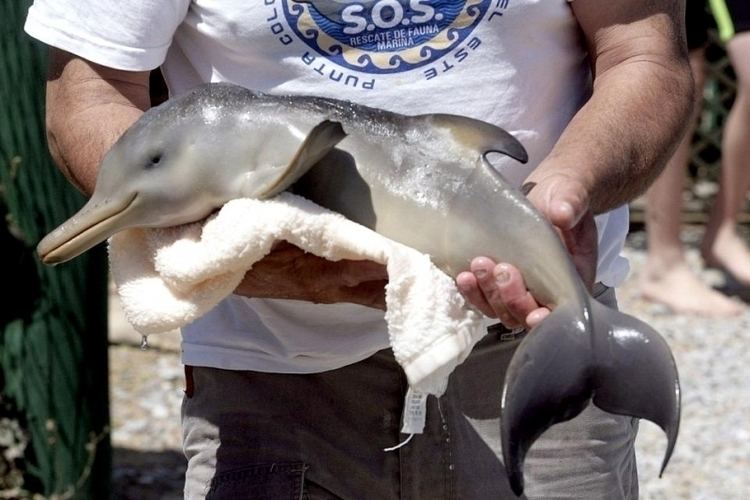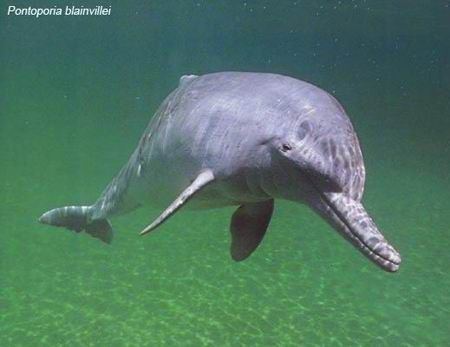Order Artiodactyla Clade Delphinida Scientific name Pontoporia blainvillei Rank Species | Phylum Chordata Superfamily Inioidea Higher classification Pontoporia | |
 | ||
Similar Cetaceans, Mammal, Sotalia, Iniidae, River dolphin | ||
La plata dolphin
The La Plata dolphin or Franciscana (Pontoporia blainvillei) is found in coastal Atlantic waters of southeastern South America. It is a member of the river dolphin group and the only one that lives in the ocean and saltwater estuaries, rather than inhabiting exclusively freshwater systems.
Contents
- La plata dolphin
- Taxonomy
- Description
- Behavior and feeding
- Range and habitat
- Threats
- Conservation
- References

Taxonomy

The La Plata dolphin is the only species in its genus, and is often placed in its own family, the Pontoporiidae. It was first described by Paul Gervais and Alcide d'Orbigny in 1844 (the species epithet blainvillei commemorates the French zoologist Henri Marie Ducrotay de Blainville). The La Plata dolphin is also widely known as the Franciscana - the Argentine and Uruguayan name that has been adopted internationally. Other common names are the toninha (the Brazilian name) and cachimbo.
Description
The La Plata dolphin has the longest beak (as a proportion of body size) of any cetacean — as much as 15% in older adults. Males grow to 1.6 m (5 ft, 3 in) and females to 1.8 m (5 ft, 10 in). The body is a greyish brown colour, with a lighter underside. The flippers are also very large in comparison with body size and are very broad, but narrow on joining the body, so are almost triangular in shape. The trailing edges are serrated. The crescent-shaped blowhole lies just in front of a crease in the neck, giving the impression that dolphin forever has its head cricked upwards. The dorsal fin has a long base and a rounded tip.

The La Plata dolphin weighs up to 50 kg (110 lb), and lives for up to 20 years. The gestation period is around 10–11 months and juveniles take just a few years to mature. Females may be giving birth by the age of five.
Behavior and feeding
The animal is very inconspicuous—it moves very smoothly and slowly—and can be difficult to spot unless estuary conditions are very calm. It will commonly swim alone or in small groups. Exceptional groups as large as 15 have been seen. La Plata dolphins are bottom feeders and gut inspections have revealed they eat at least 24 different species of fish, depending on which species are most common. They will also take octopus, squid and shrimp. They are, in turn, hunted by killer whales (orcas) and several species of sharks.
Range and habitat
The La Plata dolphin is found in the coastal Atlantic waters of southeastern South America, including the Río de la Plata estuary. Its distribution ranges from the Tropic of Capricorn near Ubatuba, Brazil, south to Península Valdés, Argentina. It is the only member of the river dolphin group that lives in the ocean and saltwater estuaries, rather than freshwater. Although some members of the species do spend portions of their lives outside of river systems, many individuals live their entire lives within rivers, never venturing into the ocean proper.
Threats
The La Plata dolphin is affected by factors like habitat destruction and water pollution. Plastic debris and synthetic material has been found in the stomach contents of these animals. More research is necessary to determine whether or not these factors negatively affect the health of La Plata dolphins.
Conservation
The La Plata dolphin is listed as "Vulnerable" in the IUCN Red List of Threatened Species. However, the Franciscana is a particular conservation concern because of its restricted distribution and vulnerability to incidental capture in fishing gear. Large numbers are killed in gillnets. Although the largest documented catches in the 1970s were in Uruguay, catches in recent decades have also been high in southern Brazil and Argentina. Scientists from all three countries have voiced their concerns, and asked for international assistance in highlighting the plight of the dolphin (see Reeves et al., pg. 53).
The species is listed on Appendix I and Appendix II of the Convention on the Conservation of Migratory Species of Wild Animals (CMS). It is listed on Appendix I as this species has been categorized as being in danger of extinction throughout all or a significant proportion of its range. CMS Parties strive towards strictly protecting these animals, conserving or restoring the places where they live, mitigating obstacles to migration and controlling other factors that might endanger them. It is listed on Appendix II as it has an unfavourable conservation status or would benefit significantly from international co-operation organised by tailored agreements.
A young La Plata dolphin was rescued in 2011 off Montevideo, Uruguay. In February 2016 a young dolphin died on the beach of Santa Teresita, Argentina. Reports circulated internationally that the dolphin's death resulted after being passed around by a crowd who were posing for selfies with it. However, an interview by the photographer of the images, Hernan Coria, contradicting such claim.
